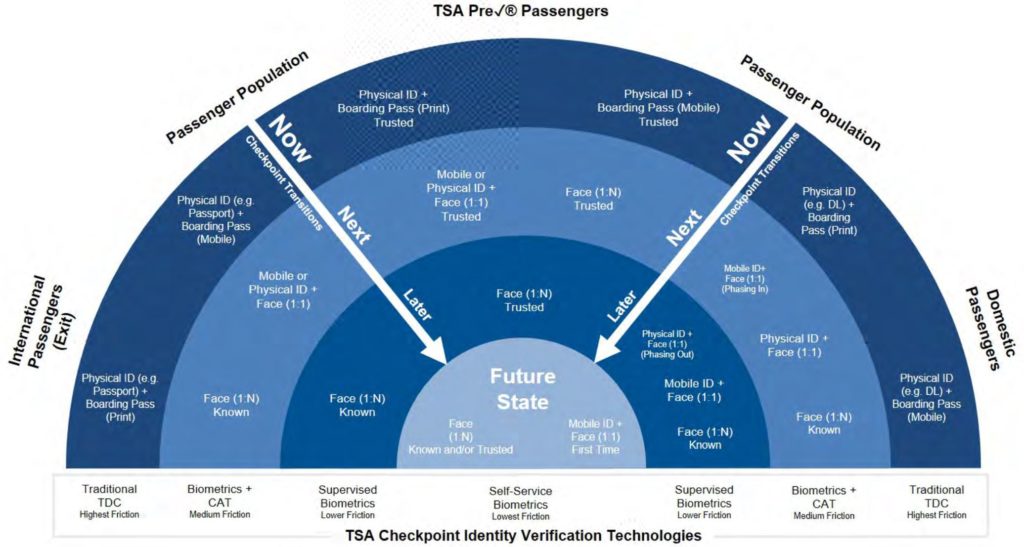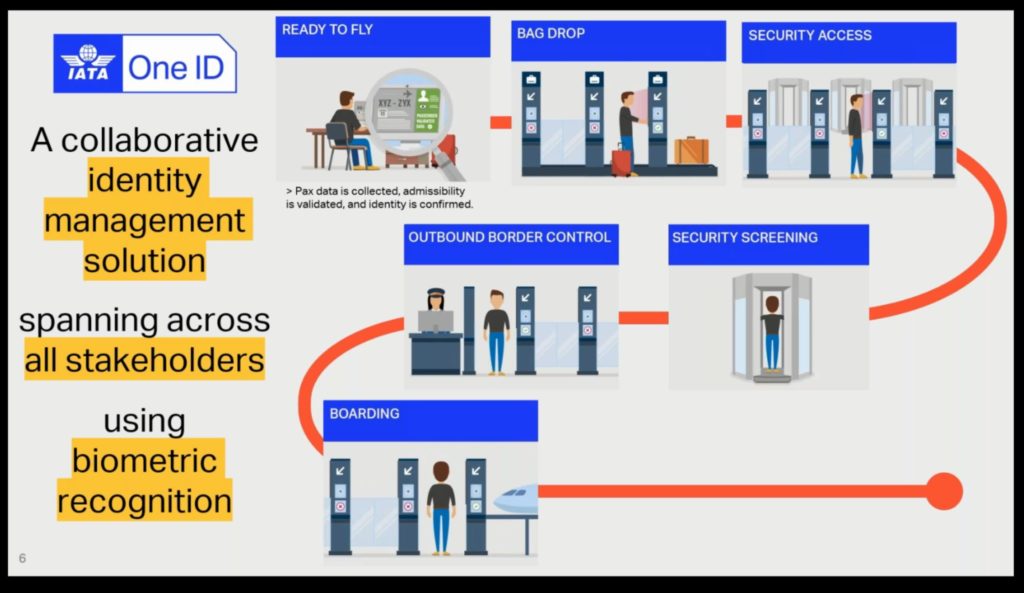The ACLU has released an important white paper on airport facial recognition by ACLU senior policy analyst Jay Stanley. Citing some of our previous reporting and analysis, the ACLU white paper focuses, appropriately, not so much on the details of current use of facial recognition at airports, but on where governments and the aviation industry — who share a an explicitly-recognized interest in common use of facial recognition — say it will lead if we don’t stop them.
Driving the dystopian trend called out in the ACLU white paper is the malign convergence of interest between governments that want to use facial recognition and other techniques of compelled and automated identification for surveillance and control of travelers’ movements; and airlines, airports, and other businesses that want to share use of the same identification systems and data for business process automation and commercial tracking and profiling of travel customers.
Below are some key excerpts, but we encourage you to read the full ACLU white paper:
Customs and Border Protection’s new airport face recognition system has attracted a lot of attention and criticism, most recently last month when the agency backed away from suggestions that it would make the program mandatory for American citizens….
CBP officials argue that this program doesn’t involve mass surveillance. But CBP’s program still involves the mass collection of photographs of the general public….
The biggest harm from this program, however, is likely to come from the investment that it represents, the precedent it sets, and the path it puts us on as a society.
And where that path leads is a nightmare. It hardly takes a paranoid flight of fancy to foresee this program morphing into something far more comprehensive and dystopian — a world where face recognition is used throughout our public spaces to scrutinize our identity, record our movements, and create a world where everyone is constantly watched….
DHS and the aviation industry as a whole have a sweeping vision of expanded use of face recognition in the air travel context, and the government itself has already laid out — and begun following — a very specific, clear, and well-defined pathway for how the current program leads to a much broader implementations of face surveillance at the airport. And from there, it will be poised to expand far beyond the airport.
Here is what that pathway looks like:…
Once face recognition becomes entrenched at TSA checkpoints, there will be enormous pressure to turn those checkpoints into broader law enforcement checkpoints where people are subject to watchlist, criminal, and immigration checks. The TSA is not a law enforcement agency, and its checkpoints are not general law enforcement stops. The TSA’s authority to search people without a warrant is strictly confined to what is necessary to protect aircraft safety; TSA agentscan’t conduct general criminal investigations when they find things suspicious….
CBP, however, does consider itself a law enforcement agency. The agency already partners with TSA in creating and applying flawed watch lists and algorithmic risk assessments of passengers based on biographical data (and secretive criteria), but CBP said in 2018 that it planned to also start running some passenger photos through the government’s IDENT biometric watchlist, which, according to DHS, includes “known or suspected terrorists, criminals, and immigration violators.” Among other things that raises the prospect that the TSA checkpoints will be turned into something new: a place where arrests of wanted people… routinely takes place….
Expanding government face recognition dovetails with airline face recognition… The airlines have a crucial role in the government’s face recognition vision. CBP is trying to create an infrastructure that the United States (unlike some other countries) has never had: border checkpoints for those exiting the country. But supporters of this system apparently don’t want it badly enough to actually pay for the government system they think we should have. Instead, they’re trying to do it on the cheap … by prodding the airlines to supply the equipment and manpower to actually run the system. And that, in turn, is implicitly based on CBP’s understanding that the airlines are embracing biometrics for their own purposes.
And the airlines are certainly interested in doing so. With over 2 million people a day flying domestically, these companies run what is essentially a giant factory for the movement of people, and are always looking for ways to improve their “industrial process.” Delta Airlines, for example, is already cooperating with CBP to experiment with face recognition for self-service check-in and bag check. Flyers presents themselves at the relevant kiosk where their photos are taken and sent to CBP’s cloud photo service. “CBP is excited at the possibility of biometric matching from curb to gate,” the agency proclaims in materials directed at its airline “partners.” “Airlines and airport authorities have an extraordinary opportunity to influence the future of secure air travel by co-developing processes that meet business, traveler and security needs.”
We’ve been down this road before. The TSA’s “Secure Flight” program, first implemented in 2009, forces passengers to hand over personal data to the airlines (their full name, gender, and date of birth) but lets the airlines do whatever they want with that information, providing a valuable data windfall for those companies. One question is whether we’ll see the same thing happen with traveler mug shots. CBP currently says the airlines won’t be permitted to keep the photographs those airlines take with their own equipment, but not that’s written in any law or regulation and it’s far from clear if and how that will be rigorously enforced….
Airport bag searches were new in American life when they were first introduced in response to a wave of hijackings in the 1960s and 1970s. Since then, they have expanded throughout American life to many office buildings, schools, museums, sports stadiums, and even some gatherings in public spaces such as fireworks on the National Mall. Unfortunately there are too many reasons to think that face recognition, if it becomes accepted at airports, will follow this existing path toward the “airportization of American life.”
CBP’s TVS program is the first government face recognition checkpoint in American history. If America decides to allow its deployment to continue, where will things go from there? We don’t have to wonder because the government has already told us much of the story. This kind of mission creep is one reason why it is important to raise awareness over, ask sharp questions about, and ultimately oppose the CBP program
The ACLU has filed a new Freedom Of Information Act request for information about DHS facial recognition programs and aviation industry partnerships. This request overlaps with several of our pending overdue and unanswered FOIA requests to the DHS and DHS components, including those for agreements between the DHS, airlines, and airports for sharing facial images and DHS presentations on use of biometrics at events with aviation industry “partners”. We look forward to the responses to the ACLU request.
Article source: PapersPlease.org
Top image: TSA Biometrics Roadmap, September 2018. Note that face ID will be used for all air travelers and that all use of physical ID credentials is “phasing out” in favor of facial recognition and digital tokens on mobile devices.
Subscribe to Activist Post for truth, peace, and freedom news. Become an Activist Post Patron for as little as $1 per month at Patreon. Follow us on SoMee, Flote, Minds, Twitter, and Steemit.
Provide, Protect and Profit from what’s coming! Get a free issue of Counter Markets today.



Be the first to comment on "The Nightmare of Airport Facial Recognition"